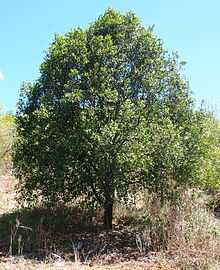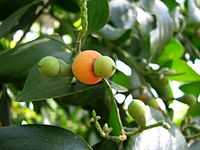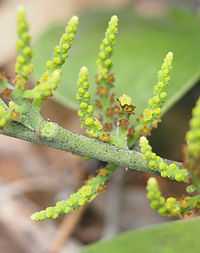Exocarpos latifolius
| Exocarpos latifolius | |
|---|---|
 | |
| Scientific classification | |
| Kingdom: | Plantae |
| (unranked): | Angiosperms |
| (unranked): | Eudicots |
| (unranked): | Core eudicots |
| Order: | Santalales |
| Family: | Santalaceae |
| Genus: | Exocarpos |
| Species: | E. latifolius |
| Binomial name | |
| Exocarpos latifolius R.Br.[1] | |
Exocarpos latifolius is a species of parasitic trees, of the plant family Santalaceae.[1] They have the common names Broad Leaved Ballart, Scrub Sandal-wood, Scrub Cherry, Oringorin, Broad Leaved Cherry or Native Cherry. The species is found in monsoon forest, littoral rainforest and occasionally in more open forest types in Malesia and across Northern Australia.[2]


It is a small tree (or large shrub) growing to 10 metres tall, hemiparasitic on the roots of other trees.[2][3][4] The leaves are approximately as broad as long, around 4 cm long. Flowers are produced in slender spikes mostly approximately 1 cm long. The fruit is a globular nut on a short stalk. As it ripens the stalk swells and turns red, like an inside out cherry. The fruit is 4–6 mm long and is inedible, though the stalk is, and was used as a traditional food source by Aboriginal Australians. The seed is found on the outside of the fruit, hence the name exocarpus, from the Latin meaning outer. The wood is very fine-grained with little figure but often striking colour variation and was historically used for cabinet work.[4]
The tree was used for many purposes by Aboriginal Australians.The bark was used as a contraceptive. The leaves were burned to repel insects and leaves used in a solution to treat sores.[4]
References
- ↑ 1.0 1.1 "Exocarpos latifolius". Australian Plant Name Index (APNI), IBIS database. Centre for Plant Biodiversity Research, Australian Government. Retrieved 15 May 2013.
- ↑ 2.0 2.1 Hyland, B. P. M.; Whiffin, T.; Zich, F. A. et al. (Dec 2010). "Factsheet – Exocarpos latifolius". Australian Tropical Rainforest Plants. Edition 6.1, online version [RFK 6.1]. Cairns, Australia: Commonwealth Scientific and Industrial Research Organisation (CSIRO), through its Division of Plant Industry; the Centre for Australian National Biodiversity Research; the Australian Tropical Herbarium, James Cook University. Retrieved 15 May 2013.
- ↑ Wiecek, B. (20 July 2001). "Exocarpos latifolius – New South Wales Flora Online". PlantNET – The Plant Information Network System. 2.0. Sydney, Australia: The Royal Botanic Gardens and Domain Trust. Retrieved 15 May 2013.
- ↑ 4.0 4.1 4.2 "Exocarpos latifolius (Santalaceae); Native cherry, broad-leaved cherry". Brisbane Rainforest Plants; Brisbane Rainforest Action & Information Network. Retrieved 15 May 2013.
| Wikimedia Commons has media related to Exocarpos latifolius. |